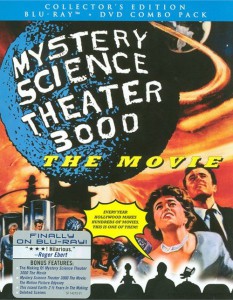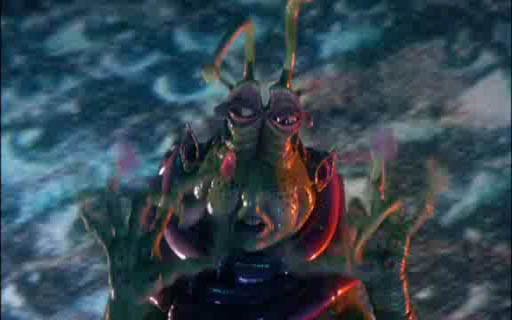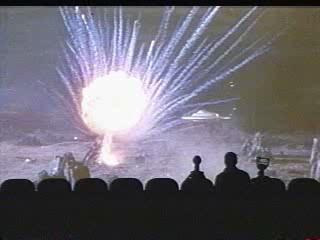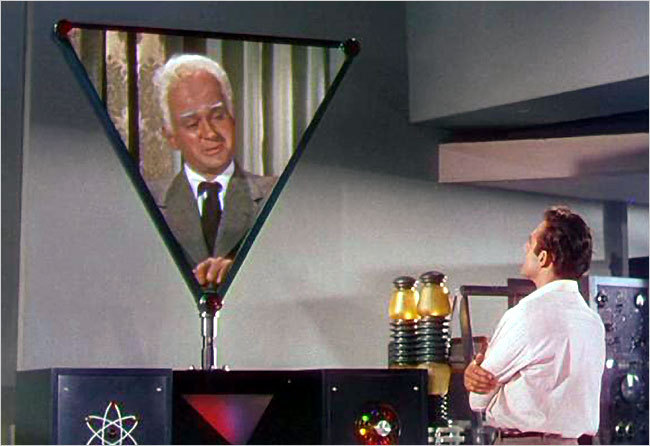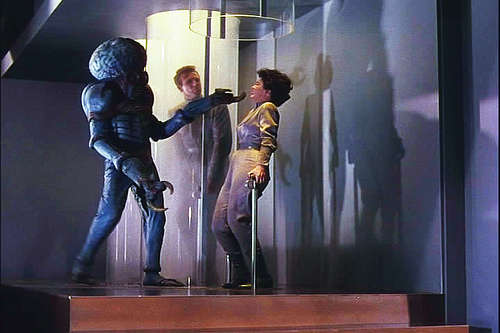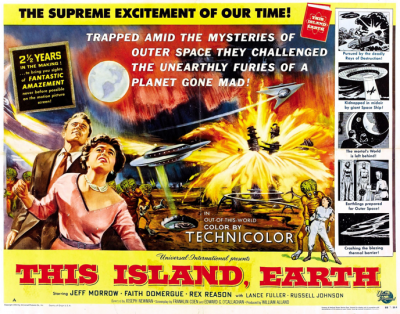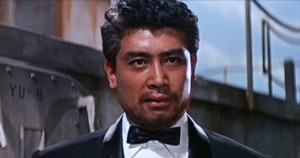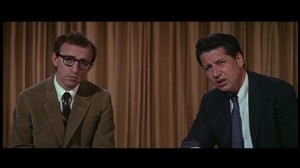From the Chicago Reader (April 19, 1996). — J.R.
Mystery Science Theater 3000: The Movie 0 (no stars)
Directed by Jim Mallon
Written by Michael J. Nelson, Trace Beaulieu, Mallon, Kevin Murphy, Mary Jo Pehl, Paul Chaplin, and Bridget Jones
With Beaulieu, Nelson, Jeff Morrow, Rex Reason, Faith Domergue, and the voices of Mallon and Murphy.
The premise of the recently discontinued cable-TV series on which this film is based is more or less as follows: a blustering mad scientist named Dr. Clayton Forrester (Trace Beaulieu) plots to take over the world. His plan? According to the Mystery Science Theater 3000: The Movie press book: “Find the worst movies ever made, show them to the entire population and bring the planet to its knees.” He kidnaps Mike Nelson (Michael J. Nelson) to serve as a guinea pig, takes him to the Satellite of Love, and makes him and his three robot pals — Tom Servo, Gypsy, and Crow — watch the Worst Movies Ever Made. But Mike and his friends confound the experiment by talking back to the screen and making wisecracks. We watch the movies too — or parts of them, since the lower portion of the screen is partially blocked by the silhouettes of Mike and two of the robots.
If the film were more imaginative, it might be taken as a spin-off of the last half hour of Joe Dante’s 1985 Explorers [see above] — our culture reconfigured through the sensibility of an extraterrestrial in a satellite, then dished out to us. But the reality is something closer to the reverse — an outmoded version of an alien sensibility reconfigured through contemporary disbelief to yield just plain dishing. And as in the current Kids in the Hall: Brain Candy, no adjustment is made in performance style: the broad gestures needed to make a mark on the tube are simply carried over to the big screen without alteration, so that the nerd characters become inflated like balloons.
The kind of humor that characterizes the Mystery Science Theater series has existed almost as long as the teenager has existed as a marketing concept — that is, since the early 50s, when television started becoming widespread. Talking back to the screen has probably been around much longer — especially in the cheap second- and third-run houses that proliferate in cities — though there’s something about the snugness of a car at a drive-in or the privacy of a den or living room that encourages this behavior.
Of course making up your own wisecracks and passively listening to the wisecracks of ersatz spectators aren’t precisely the same activity. The potential creativity of the audience has been usurped, which reminds me of United Artists’ recent efforts to remarket Showgirls to gay audiences after failing to attract many heterosexuals. In New York, and perhaps elsewhere, publicists have manufactured a supposedly spontaneous cult by encouraging drag queens to turn up for midnight screenings and call out rejoinders to the screen dialogue, as audiences do with The Rocky Horror Picture Show, though in this case the studio has thoughtfully provided some of the one-liners. The flacks seem to be saying, you too can climb on the bandwagon of a hip subculture, and leave the driving to us. (According to the Mystery Science Theater 3000 press book, the original series “spawned a MST3K fan club that numbers more than 50,000 strong” — though whether it too was created or helped along by publicists isn’t clear.)
One reason I never watched the cable-TV show for more than a few minutes at a time was that the range of movies Mike and the robots could watch was very narrow: they had to be science fiction or horror, most were in black and white, and almost all were made in the 50s. If copyright laws were looser and the writers of this show more enterprising, we might have seen Mike and his pals sharpening their wits on Woody Allen’s ponderous Bergman imitations, such as Interiors and September; on the New Age soul-searching in Henry Jaglom pictures; and maybe even on sacred cows like Schindler’s List. The results might have made more people angry, but at least things would have been livelier, and the writers might have been forced to think up better jokes. Instead the writers opted for the most cliched, simpleminded, and unreflecting idea of what a bad movie is, then adhered to that as if it were gospel.
In Mystery Science Theater 3000: The Movie the filmmakers have expanded their range enough to allow the feature to be in color — undoubtedly because they don’t want TV networks paying less to show it. But they’ve hit a fatal snag. The feature they selected happens to be a pretty good one — certainly much better than Mystery Science Theater 3000: The Movie by just about any criterion one could think of (story, pacing, dialogue, visual design, characterization, even acting). The filmmakers were clearly counting on audiences believing that any science fiction movie made in the 50s is idiotic by definition, because back then they didn’t know all the cool stuff we know today. (A typical exegesis: “Oh yeah, that’s when science didn’t have any specific purpose.”) It’s true that we know more about science than people in the 50s did. What we clearly know less about is how to make movies.
I hasten to add that the “stinkburger” the filmmakers selected, This Island Earth (1955), isn’t even shown complete. It’s shown throughout at the wrong screen ratio, with large sections of the bottom of each frame cut off and another section obscured by the silhouettes of Gypsy, Mike, and Tom (who always occupy seats 7 through 9 in a row of 11 seats — the theater’s capacity, apparently). Its running time is also cut: MST3000 runs 73 minutes, but This Island Earth runs 86. Yet more than 13 minutes are deleted, because plenty goes on before and after the screening of This Island Earth, and on two occasions the projector breaks down, leaving our furry friends to crack more jokes until it’s fixed. Needless to say, these are the worst passages, worst of all when the movie halfheartedly tries to imitate This Island Earth in a few of its visual conceits. But despite all the mauling and all the lousy wisecracks, many of the virtues of This Island Earth shine through — enough to make one regret that Gramercy Pictures didn’t simply rerelease the older movie.
I’m far from being alone in this estimation of This Island Earth. Leonard Maltin’s reasonable, middle-of-the-road Movie and Video Guide gives the film three stars, calling it “suspenseful,” “intelligent,” “thoughtful,” and “exciting,” “with excellent visuals”; I can’t imagine anyone using those words to describe Mystery Science Theater 3000: The Movie. And the adventurous English critic Raymond Durgnat devotes most of the final chapter of his first book, the 1967 Films and Feelings, to the film, finding its story a reflection of American attitudes during the cold war and appreciating, with some critical reservations, its “moral suspense” as well as its poetic imagery.
I’m not trying to argue that This Island Earth is any sort of masterpiece or that it doesn’t have a silly side; I recall being aware of its risible aspects at age 11 — even without the relentless prodding of writer-director Jim Mallon and his half dozen cowriters. (Were they required to come up with, say, 20 wisecracks each? How much did they get paid for each one?)
What This Island Earth has that MST3000 and most other contemporary movies lack is an attractive (if clean and simple) visual design and a somewhat nuanced moral sense, two qualities it shares with The Day the Earth Stood Still (1951) and Forbidden Planet (1956). Like The Day the Earth Stood Still, it postulates a patriarchal, peace-loving extraterrestrial who’s trying to end war on earth (albeit an extraterrestrial who’s in conflict with the beings on his own and another planet); and like Forbidden Planet, it creates an attractive, if much more modest, stretch of otherworldly landscape and architecture. The film was directed by Joseph M. Newman, a fairly routine but competent action director; adapted by George Callaghan from three short stories by Raymond F. Jones that were later reworked into a novel; produced by William Alland, who played the semiinvisible reporter Thompson in Citizen Kane; and released by Universal Pictures. (The lovely 50s Universal logo occasions the first and in some ways the best of all MST3000‘s wisecracks: “This is the nicest weather earth ever had.”)
What does it tell us that close to half of the one-liners in MST3000 are homophobic? Is this supposed to reflect what teenagers in the mid-1990s find funny? I don’t know, but whenever two men are seen in any kind of physical proximity, sexual desire tends to be part of the punch line: “I’m gonna curl up in his sock drawer and sleep for days,” “I just know they’re going to probe my anus,” “Ooooh — Brock has visible panty line.” Just as surely, when a German character turns up the inevitable wisecrack is “Heil Hitler.”
I admit that the Woody Allen movie that made me laugh the loudest when it first came out — the one he usually omits from his filmographies, What’s Up, Tiger Lily? (1966), which redubs a Japanese James Bond spin-off with snide one-liners — offers variations on the same jokes (“Could this be the body of a killer?”). But if memory serves, these jokes were fewer and wittier. Here they seem motored by sheer desperation, as are such zingers as “No tickee, no shirtee,” “Keanu Reeves in My Own Private Airfield,” “Contact Aunt Jemima — start warming the syrup,” “This planet should comb its hair over its bald spot,” “That’s one butt-ugly planet you got there,” and “He’s flown into a Flemish painting” — though the simple, hilly country landscape looks nothing like a Flemish painting. But I guess if you see a country landscape you’ve got to say something to prove how smart you are.


